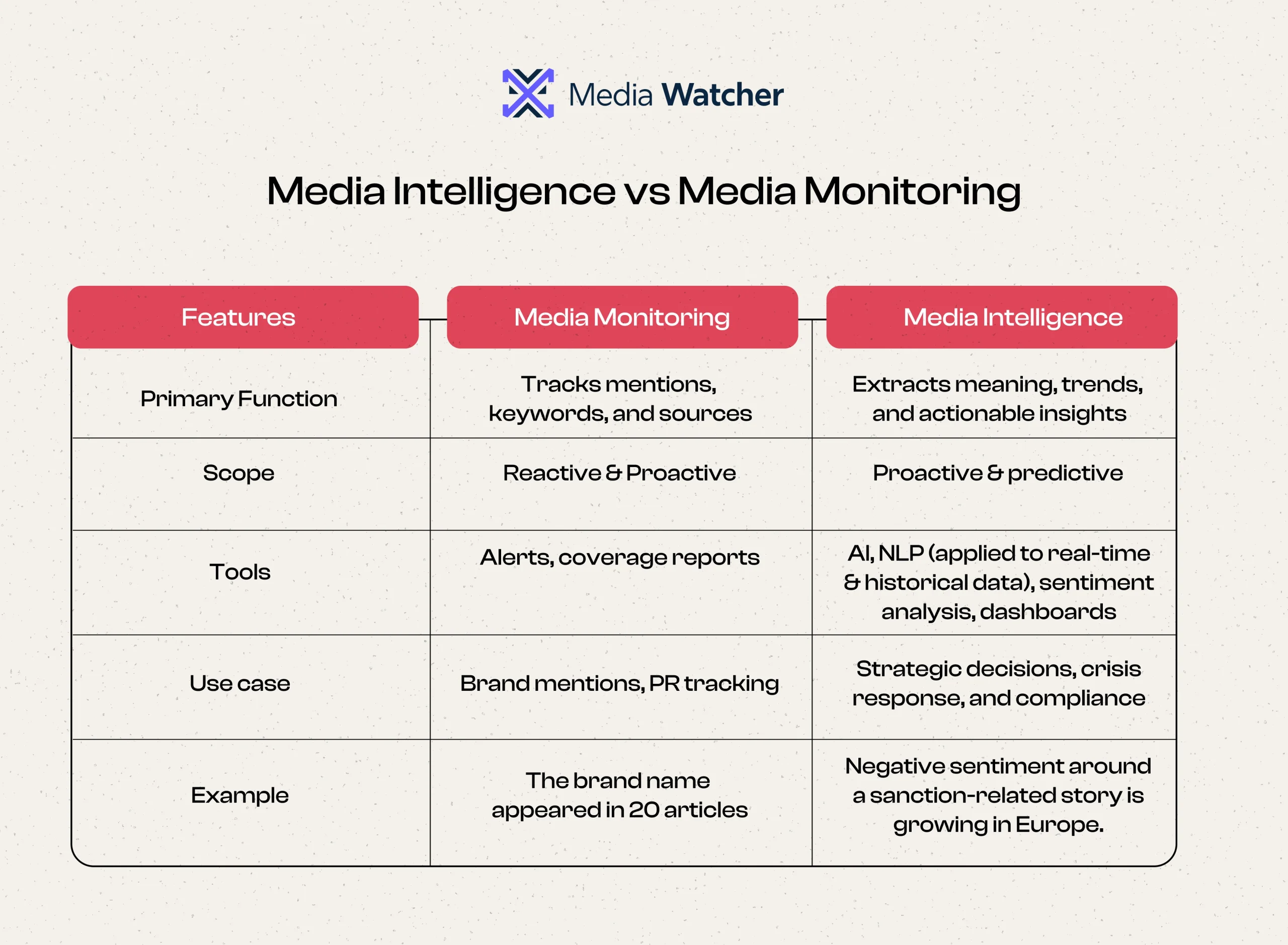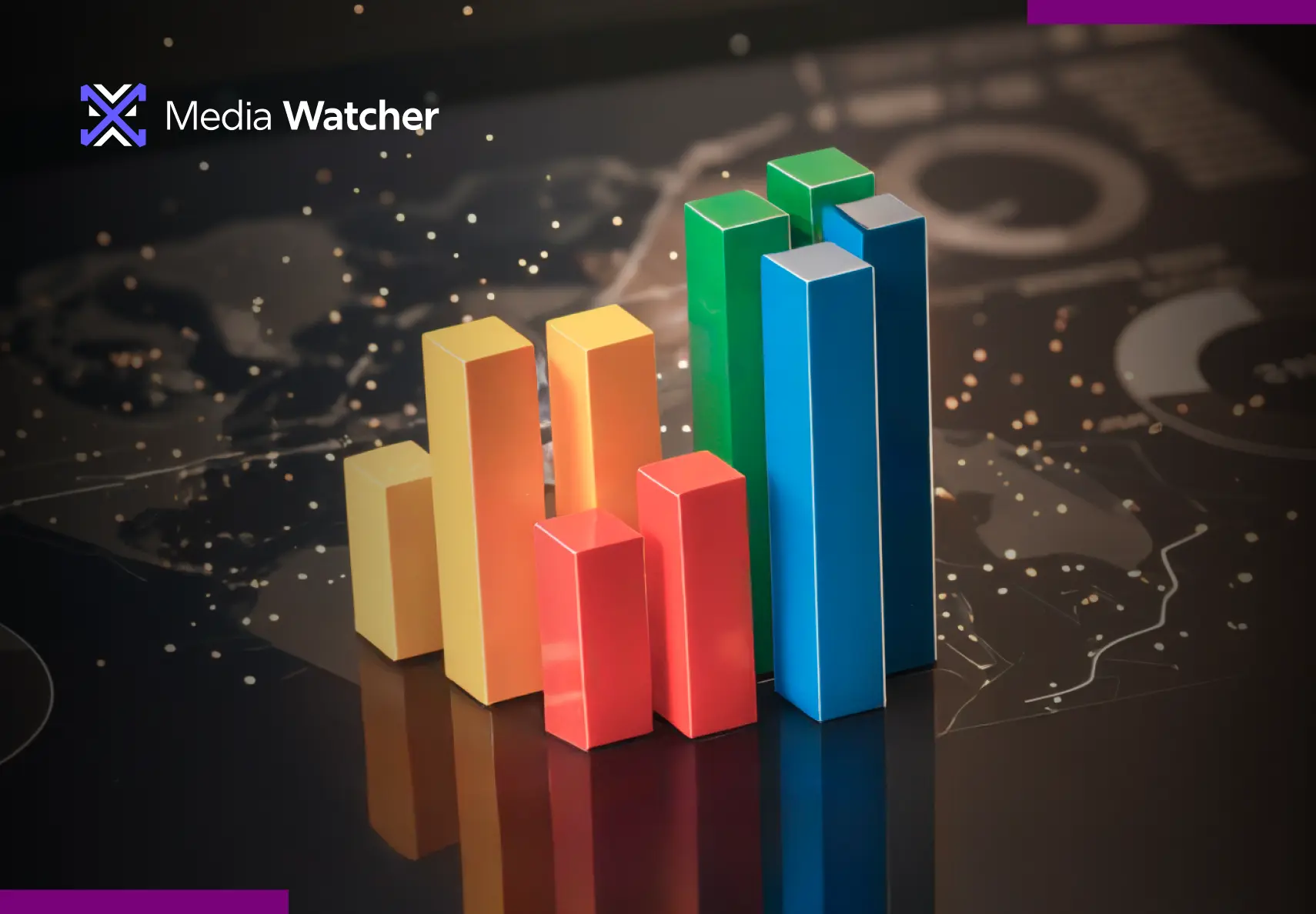What happens when your next crisis is not top headlines but already simmering in a Reddit post, a comment on TikTok, or a news site in a country you have never heard of?
In a 24/7 journalism milieu, reputations do not just erode in the headlines; patterns in the data quietly shape them. Most teams are not trained to read. A Forrester research conducted in 2025 showed that more than 78% of business leaders failed to detect an early warning of a reputational threat because they lacked the proper intelligence tools, as the previous strategy of simple-minded monitoring of mentions was no longer sufficient.
Businesses that genuinely want to stay ahead need to become predictive rather than reactive, and the first step towards this transition involves mastering the pillars of media intelligence. These include media monitoring, sentiment analysis, social listening, and real-time alerts, not merely capturing the noise, but decoding its meaning, direction, and potential risk.
What is Media Intelligence?
Media intelligence is the process of analyzing media-sourced information across various local and global channels to extract meaningful insights that help in making better decisions. In contrast to regular media monitoring, media intelligence goes deeper than mere tracking of keywords, mentions, or coverage. Through AI-powered tools and Natural Language Processing, it analyzes the sentiments, narratives, trends, and competitor signals.
It is a method of providing strategic value to raw data that allows organizations to gain insights into how people are thinking about them, to anticipate new storylines, benchmark against competitors, and make decisions based on patterns in conversation that occur over time.
Media Intelligence vs Media Monitoring
The terms media monitoring and media intelligence are often used interchangeably, yet their functions are quite contrary to one another. Media monitoring involves monitoring mentions, keywords, and coverage, whereas media intelligence is concerned with interpreting that information to make sense and help with decision-making.

What are the Four Pillars of Media Intelligence?
Public conversations define the way brands are perceived every day. Whether it is in news headlines or through social media, information flows constantly, and this can affect reputation and customer behavior. Media Intelligence enables companies to translate these discussions into useful knowledge by using the appropriate tools. It can be done through media intelligence services to make better decisions based on what occurs around you. This process is based on four pillars of media intelligence, which are given below in detail for better comprehension:
1. Media Monitoring
Media monitoring starts with tracking news articles, blogs, online discussions, and press releases to identify when a product, topic, or competitor is being mentioned. Intelligence media monitoring tools allow companies to search thousands of sources in real time across regions and languages.
This keeps them informed of the advancements, quantifies media exposure, and identifies early warning of risk or opportunity. A well-built media intelligence platform ensures nothing important slips through the cracks.
2. Sentiment Analysis
It is not just enough to know what is being said, but also to know how people feel about this. Sentiment analysis assists in breaking down the tone of a response, which will be rated either positive, negative, or neutral. This is one of the fundamental capabilities of the top media intelligence providers.
Such analysis assists teams in determining whether public response is consistent with brand goals or there is a need to change messaging. The need to sense emotion in any language and in any format has become a critical component of brand monitoring over the changing pattern of media intelligence.
3. Social Listening
Social listening is about paying attention to broader conversations that may not mention a brand directly. It comprises responses, remarks, or views prioritized on the internet groupings, forums, and web-based communities.
Social listening enables media intelligence solutions to identify trends, explore consumer interests, and highlight rising issues. Utilizing big data in media intelligence, these solutions have the potential to analyze millions of posts and find insights that inform future strategy.
 4. Real-Time Alerts
4. Real-Time Alerts
Another feature of media intelligence tools is the ability to receive real-time alerts that can update users when something significant occurs, be it a surge in activity, a breaking news item, or a spike in sentiment. These alerts enable teams to respond promptly, particularly in case of a crisis or in a major campaign. It brings urgency and clarity into the decision-making process, making sure you’re not reacting too late.
The four pillars of media intelligence provide the foundation and direction for how media insights are gathered and applied. Combined with the assistance of powerful media intelligence tools and services, the organizations may develop a rationalization of the general discourse, follow the relevant media intelligence trends, and use big data analytics to transform raw content into implementable conclusions.
How can the Pillars of Media Intelligence Assist in Informed Decision-Making?
The real benefit of media intelligence is not only in monitoring what is being said, but in understanding how to respond to it. All four pillars of media intelligence hold specific functions in providing clarity, context, and confidence to stakeholders. In addressing a potential crisis or developing a long-term strategy, these pillars assist an organization in qualifying a collection of disparate information into a manageable path forward.
1. Catch Narrative Before the Headlines Hit
Media monitoring intelligence identifies emerging anomalies in how your brand, or those of competition, and industry-related topics are being framed across geographies, media, and audience segments. This enables teams to intervene before misinformation goes viral or sentiment becomes hostile.
2. Gauge Emotional Impact of Decisions
Sentiment analysis not only identifies approval or disapproval, but also the strength of emotions. When implementing new policies or addressing new rounds of criticism, this understanding assists decision makers in smoothing out the tone, timing, or message before perception solidifies.
3. Identify Market Gaps Hidden in Online Chatter
Social listening indicates missed desires not only regarding your brand, but in the industry as a whole. Niche platforms, subreddits, and forums will regularly reveal holes that competitors have overlooked, providing the chance to innovate or reposition in the short term.
4. Real-Time Responses to Vulnerabilities
Smart notifications extend beyond volume to detect changes in association, tone, and influencer traction. Rapid insight enables immediate response strategies when a brand is unexpectedly associated with a popular topic or controversy.
5. Move From Isolated Data to Shared Strategy
The pillars of media intelligence form a central flow of actionable intelligence out of media presence, community opinion, and competitor background. This common ground means that there is agreement on a common strategic playbook between marketing, comms, and leaders.
Explore the Power and Business Value of Media Intelligence with Media Watcher
There is no longer a linear flow of media stories; they accumulate over platforms, languages, and boundaries in real-time. Narrative iteration could lead to influencing the court of public opinion by the time traditional monitoring reveals it. That is why modern media teams are using Media Watcher not only to view events but to gain a clear understanding of the reasons behind them.
Media Watcher is more than shallow tracking. It assists businesses in:
- Spot early signals from news sites, podcasts, social media, and forums, even in less-covered regions or languages.
- Filter out the noise and focus on high-impact mentions tied to your brand, competitors, or key topics.
- Understand tone shifts with accurate sentiment analysis that picks up emotional cues and bias, not just positive or negative tags.
- Get notified in the moment when volume spikes or sentiment turns, so you are never left reacting too late.
Instead of juggling multiple tools or spending hours digging through irrelevant content, teams get a single place to track, interpret, and act on media narratives as they unfold.
Contact the Media Watcher team and book a demo today!




